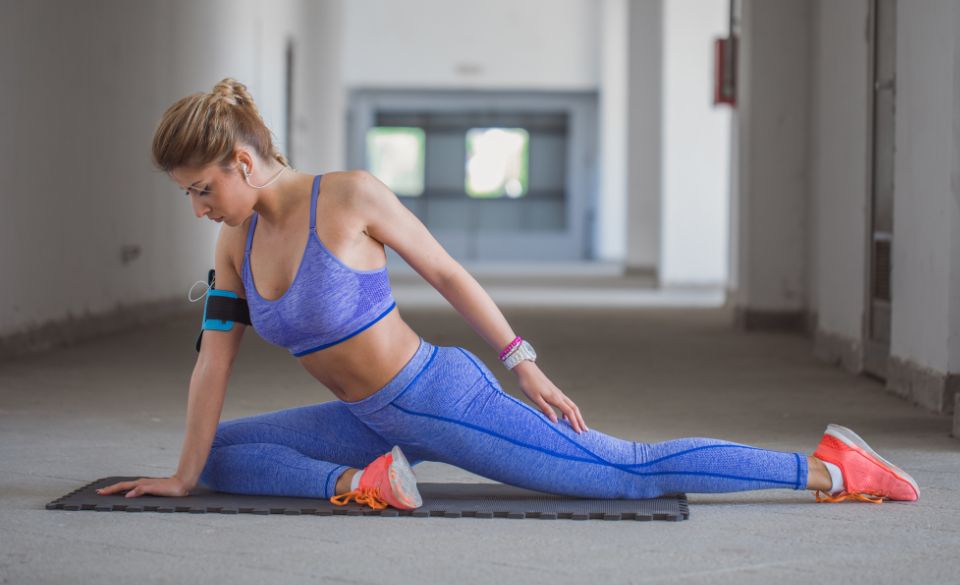
Flexibility Fast-Track: 5 Effective Strategies to Boost Your Flexibility
Page Contents
- 1. Dynamic Stretching: The Gateway to Supple Muscles
- 2. PNF Stretching: Partner Up for Rapid Results
- 3. Yoga: Uniting Flexibility and Mindfulness
- 4. Foam Rolling: Self-Care for Enhanced Flexibility
- 5. Consistency and Gradual Progression: Flexibility’s Best Allies
- Integrating Flexibility into Your Lifestyle: A Holistic Approach
- The Journey Never Ends: A Lifelong Quest for Flexibility
If you’ve ever marveled at the graceful fluidity of a dancer or the effortless contortions of a yogi, you’ve likely pondered the secrets behind their enviable flexibility. The good news? You don’t need to be a performer to achieve remarkable flexibility gains. Whether you’re aiming to touch your toes with ease or nail that elusive split, this guide unveils five powerful strategies that can propel your flexibility journey into high gear.
1. Dynamic Stretching: The Gateway to Supple Muscles
Dynamic stretching serves as an invigorating prelude to your flexibility endeavors. Unlike static stretching, where you hold a position, dynamic stretches involve controlled movements that gently take your muscles through a range of motion. Research published in the Journal of Sports Sciences highlights the efficacy of dynamic stretching in improving flexibility and functional movement. Incorporate leg swings, arm circles, and hip rotations into your warm-up routine to increase blood flow, boost joint mobility, and prepare your muscles for deeper stretches.
2. PNF Stretching: Partner Up for Rapid Results
Proprioceptive Neuromuscular Facilitation (PNF) stretching is a game-changer when it comes to rapid flexibility gains. This technique involves a cycle of contraction and relaxation to reset your muscle’s natural length. A study in the International Journal of Sports Physical Therapy underscores PNF stretching’s effectiveness in improving flexibility and range of motion. Partner up or use a resistance band to perform PNF stretches – start by stretching the muscle, then isometrically contract it against resistance, and finally, relax into a deeper stretch. This method taps into your body’s neurological reflexes to create swift flexibility improvements.
3. Yoga: Uniting Flexibility and Mindfulness
The ancient practice of yoga isn’t just about striking elegant poses – it’s a holistic journey that harmonizes body and mind. Numerous studies, including research in the International Journal of Yoga, emphasize yoga’s positive impact on flexibility, balance, and mental well-being. Incorporate dynamic yoga sequences and poses that focus on flexibility, such as the Forward Fold, Downward Dog, and Cobra. The mindful breathwork and intentional movement characteristic of yoga not only enhance your body’s suppleness but also cultivate a deeper connection between mind and body.
4. Foam Rolling: Self-Care for Enhanced Flexibility
Foam rolling isn’t just reserved for post-workout muscle relief – it’s also a valuable tool for improving flexibility. A study published in the Journal of Athletic Training highlights foam rolling’s potential to increase range of motion and muscle flexibility. By applying controlled pressure to specific muscle groups, foam rolling releases muscle tension and adhesions, allowing for improved muscle extensibility. Focus on rolling areas prone to tightness, such as your calves, hamstrings, and quadriceps, to promote suppleness and mobility.
5. Consistency and Gradual Progression: Flexibility’s Best Allies
Amidst the excitement of pursuing rapid flexibility gains, it’s crucial to embrace the concepts of consistency and gradual progression. A study in the Journal of Human Kinetics emphasizes that regular, sustained stretching sessions are key to achieving and maintaining flexibility improvements. Dedicate time to stretching daily, focusing on both major muscle groups and areas of personal tightness. Additionally, prioritize gradual progression – aim to stretch slightly further each time while respecting your body’s limits. Over time, this patient approach allows your muscles and connective tissues to adapt and become more pliable.
Integrating Flexibility into Your Lifestyle: A Holistic Approach
As you immerse yourself in the world of flexibility enhancement, it’s important to recognize that flexibility isn’t an isolated pursuit – it’s a facet of your overall health and well-being. Embracing a holistic approach can amplify the benefits you reap from your flexibility journey.
Mind-Body Connection: The Heart of Flexibility
Flexibility isn’t solely about physical prowess; it’s also a powerful avenue for nurturing the mind-body connection. Mindfulness practices, such as meditation and deep breathing, complement your flexibility efforts by fostering relaxation and enhancing proprioception. Research published in the Journal of Mindfulness highlights how mindfulness interventions can positively impact flexibility and overall mental well-being. Incorporate mindful moments into your stretching routine, allowing yourself to be fully present in each stretch and tuning into your body’s sensations.
Nutrition for Flexibility: Fueling Your Elasticity
While it may not be immediately obvious, nutrition plays a role in supporting flexibility. Adequate hydration, for instance, promotes optimal joint lubrication and muscle function. Incorporate water-rich foods like fruits and vegetables into your diet to aid in maintaining supple tissues. Additionally, include foods rich in essential fatty acids – such as salmon, flaxseeds, and walnuts – to support joint health. Remember, the nutrients you provide your body contribute to its overall elasticity and well-being.
Mindful Recovery: Nurturing Flexibility Gains
As you stretch and expand your physical boundaries, don’t underestimate the importance of recovery in your flexibility journey. Adequate sleep, as highlighted in research from the Journal of Sports Sciences, is essential for muscle recovery and overall tissue health. Prioritize restful sleep to allow your body to repair and rejuvenate. Incorporate post-stretching techniques like foam rolling and gentle static stretches to ease any lingering muscle tension and aid in the recovery process.
Embracing Flexibility Beyond the Mat
Flexibility isn’t confined to a yoga mat or a stretching session – it transcends into your daily life. Pay attention to your body’s movement patterns as you go about your day. Practice good posture, engage in ergonomic adjustments at work, and move mindfully to prevent muscle imbalances and stiffness. Incorporate dynamic stretching as a brief break during prolonged periods of sitting to keep your muscles engaged and supple.
The Journey Never Ends: A Lifelong Quest for Flexibility
While the strategies outlined in this guide offer a springboard to rapid flexibility gains, it’s important to remember that flexibility is an ongoing journey. It’s not a destination you reach and cross off your list – it’s a way of moving through life with grace and ease. As you continue to incorporate these strategies into your routine, you’re setting the stage for a lifelong quest for flexibility and vitality.
Every stretch, every pose, and every moment of mindfulness adds to the tapestry of your flexibility journey. Celebrate not only the monumental achievements, such as touching your toes for the first time, but also the small victories – the increased range of motion, the reduced muscle tightness, and the enhanced sense of well-being.
In the grand symphony of your life, flexibility is the harmonious melody that accompanies you through every movement, every endeavor, and every challenge. So, step onto your mat, engage in dynamic stretches, practice PNF techniques, and let yoga be your guide. Embrace each opportunity to nurture your body’s suppleness and cultivate a deeper connection between body, mind, and spirit.



